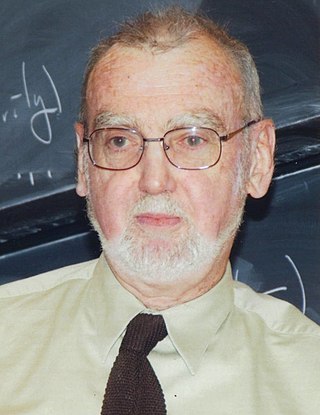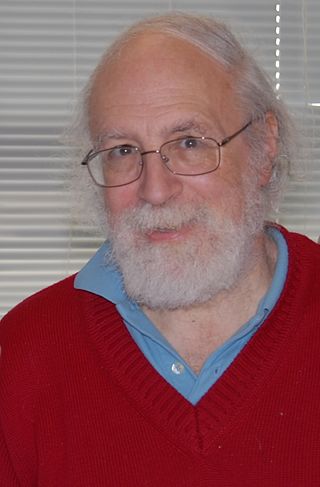
Robert Phelan Langlands, is a Canadian mathematician. He is best known as the founder of the Langlands program, a vast web of conjectures and results connecting representation theory and automorphic forms to the study of Galois groups in number theory, for which he received the 2018 Abel Prize. He is emeritus professor and occupied Albert Einstein's office at the Institute for Advanced Study in Princeton, until 2020 when he retired.
In representation theory and algebraic number theory, the Langlands program is a web of far-reaching and consequential conjectures about connections between number theory and geometry. Proposed by Robert Langlands, it seeks to relate Galois groups in algebraic number theory to automorphic forms and representation theory of algebraic groups over local fields and adeles. Widely seen as the single biggest project in modern mathematical research, the Langlands program has been described by Edward Frenkel as "a kind of grand unified theory of mathematics."
Gorō Shimura was a Japanese mathematician and Michael Henry Strater Professor Emeritus of Mathematics at Princeton University who worked in number theory, automorphic forms, and arithmetic geometry. He was known for developing the theory of complex multiplication of abelian varieties and Shimura varieties, as well as posing the Taniyama–Shimura conjecture which ultimately led to the proof of Fermat's Last Theorem.

Elias Menachem Stein was an American mathematician who was a leading figure in the field of harmonic analysis. He was the Albert Baldwin Dod Professor of Mathematics, Emeritus, at Princeton University, where he was a faculty member from 1963 until his death in 2018.
In number theory, Tate's thesis is the 1950 PhD thesis of John Tate completed under the supervision of Emil Artin at Princeton University. In it, Tate used a translation invariant integration on the locally compact group of ideles to lift the zeta function twisted by a Hecke character, i.e. a Hecke L-function, of a number field to a zeta integral and study its properties. Using harmonic analysis, more precisely the Poisson summation formula, he proved the functional equation and meromorphic continuation of the zeta integral and the Hecke L-function. He also located the poles of the twisted zeta function. His work can be viewed as an elegant and powerful reformulation of a work of Erich Hecke on the proof of the functional equation of the Hecke L-function. Erich Hecke used a generalized theta series associated to an algebraic number field and a lattice in its ring of integers.
In mathematics, the local Langlands conjectures, introduced by Robert Langlands, are part of the Langlands program. They describe a correspondence between the complex representations of a reductive algebraic group G over a local field F, and representations of the Langlands group of F into the L-group of G. This correspondence is not a bijection in general. The conjectures can be thought of as a generalization of local class field theory from abelian Galois groups to non-abelian Galois groups.
János Kollár is a Hungarian mathematician, specializing in algebraic geometry.
Louis Auslander was a Jewish American mathematician. He had wide-ranging interests both in pure and applied mathematics and worked on Finsler geometry, geometry of solvmanifolds and nilmanifolds, locally affine spaces, many aspects of harmonic analysis, representation theory of solvable Lie groups, and multidimensional Fourier transforms and the design of signal sets for communications and radar. He is the author of more than one hundred papers and ten books.
Freydoon Shahidi is an Iranian American mathematician who is a Distinguished Professor of Mathematics at Purdue University in the U.S. He is known for a method of automorphic L-functions which is now known as the Langlands–Shahidi method.
In mathematics, the Langlands–Shahidi method provides the means to define automorphic L-functions in many cases that arise with connected reductive groups over a number field. This includes Rankin–Selberg products for cuspidal automorphic representations of general linear groups. The method develops the theory of the local coefficient, which links to the global theory via Eisenstein series. The resulting L-functions satisfy a number of analytic properties, including an important functional equation.
In mathematics, an automorphic L-function is a function L(s,π,r) of a complex variable s, associated to an automorphic representation π of a reductive group G over a global field and a finite-dimensional complex representation r of the Langlands dual group LG of G, generalizing the Dirichlet L-series of a Dirichlet character and the Mellin transform of a modular form. They were introduced by Langlands (1967, 1970, 1971).

Shmuel Agmon is an Israeli mathematician. He is known for his work in analysis and partial differential equations.
In mathematics, the term standard L-function refers to a particular type of automorphic L-function described by Robert P. Langlands. Here, standard refers to the finite-dimensional representation r being the standard representation of the L-group as a matrix group.

Irwin Kra is an American mathematician, who works on the function theory in complex analysis.
Michael Eugene Taylor is an American mathematician working in partial differential equations.
Haruzo Hida is a Japanese mathematician, known for his research in number theory, algebraic geometry, and modular forms.
Erez M. Lapid is an Israeli mathematician, specializing in automorphic forms, L-functions, representation theory, and the Selberg–Arthur trace formula.

Stephen James Rallis was an American mathematician who worked on group representations, automorphic forms, the Siegel–Weil formula, and Langlands L-functions.
David Soudry is a professor of mathematics at Tel Aviv University working in number theory and automorphic forms.
James Wesley Cogdell is an American mathematician.





